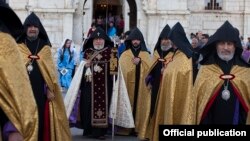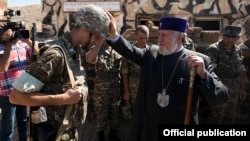Catholicos Garegin (Karekin) II and the heads of worldwide dioceses of the Armenian Apostolic Church have converged on Nagorno-Karabakh for a three-day meeting timed to coincide with the 25th anniversary of the territory’s declaration of independence from Azerbaijan.
Garegin hailed the “glorious jubilee of the most significant event in our modern history” after the regular session of the church’s Supreme Spiritual Council (SSC) that drew to a close on Thursday evening.
“The people of Artsakh (Karabakh), despite all difficulties, continue to heroically endure to build a prosperous future for their homeland,” he said in a sermon read out at Karabakh’s largest church located in the town of Shushi (Shusha).
“Our Holy Apostolic Church with its dioceses and church organizations throughout the world stands with you, dear beloved people of Artsakh, and supports every effort which is made towards the recognition of the independence of the Nagorno-Kharabakh Republic,” he said.
“Artsakh is in the soul of all Armenians,” the supreme head of the Armenian Church added after leading a procession of senior clergymen to Shushi’s 19th century Holy Savior Church.
They were greeted by hundreds of local worshippers. Karabakh’s leadership also attended the ceremony.
Earlier on Thursday, Garegin and other SSC members visited Karabakh Armenian troops deployed along “the line of contact” with Azerbaijani forces. An Armenian Apostolic Church statement said Garegin donated a cross icon to a frontline chapel and wished soldiers serving there a “triumphant return to their homes.”
All Armenian churches in Karabakh, including the 13th century Gandzasar Monastery, were forcibly shut down after the region was incorporated into Soviet Azerbaijan in the 1920s.
The Armenian Church resumed its legal activities there in 1989 one year after the Karabakh Armenians began campaigning for unification with Armenia. According to the local diocese of the Armenian Church, 70 Christian worship sites have been built or renovated in Karabakh since then.





